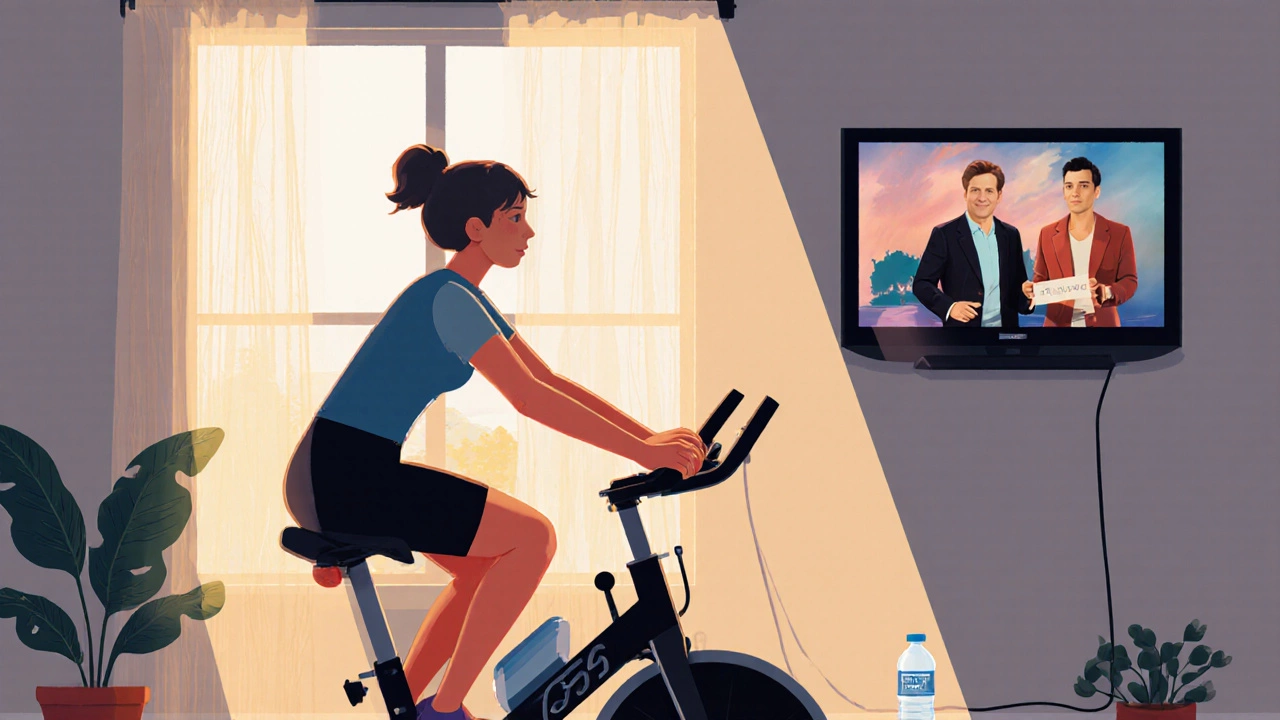
Daily Cardio Recommendation Calculator
Daily Cardio Assessment
Your Daily Cardio Recommendation
Tip: Remember the "talk test" - you should be able to speak in full sentences without gasping for air.
If you’re asking what cardio you should do every day, you’re not alone. Most people want to move more, feel better, and build stamina-but they don’t want to run themselves into the ground. The truth? You don’t need to crush yourself with high-intensity workouts seven days a week. In fact, doing the wrong kind of cardio daily can lead to burnout, joint pain, or just quitting altogether.
Start with what your body can handle
The best daily cardio isn’t the hardest. It’s the one you can stick to. Think about your energy levels, your schedule, and your joints. If you’re just getting started, walking is your secret weapon. A 30-minute walk at a brisk pace-enough to raise your heart rate but still let you talk-burns about 150 calories and lowers your risk of heart disease. Studies from the American Heart Association show that people who walk daily cut their stroke risk by nearly 30%. And it’s free. No gym membership needed.Walking isn’t flashy, but it’s the foundation. Once you’re comfortable with 30 minutes a day, you can mix in other low-impact options. Try cycling on a stationary bike for 20 minutes. Or take a swim. Water supports your body, so it’s gentle on knees and hips. Even if you only do 15 minutes, it counts. Consistency beats intensity every time.
Don’t force yourself into high-intensity every day
HIIT is popular. It’s short, it’s intense, and it promises big results. But doing burpees or sprints every single day? That’s a recipe for overtraining. Your body needs recovery. Muscles repair during rest, not during the workout. Pushing hard daily raises cortisol levels, which can actually make it harder to lose fat and easier to get injured.Instead, aim for one or two high-intensity sessions per week. Save those for when you feel fresh. On other days, keep it steady. Think of it like driving a car-you don’t floor the gas pedal every minute. You cruise. You coast. You ease into the next gear.
Try these five daily cardio options (and when to use them)
- Brisk walking - Best for mornings, recovery days, or if you’re new. Do 30-45 minutes. Keep your pace at 4-5 km/h.
- Stationary cycling - Great if you have knee issues or want to build leg endurance. Try 20-30 minutes at moderate resistance.
- Swimming or water aerobics - Perfect for joint pain or hot days. Even 15-20 minutes gives you full-body movement.
- Stair climbing - Use stairs at home or in a building. Ten minutes of steady climbing equals about 20 minutes of walking in calorie burn.
- Dancing - Put on your favorite music and move. No technique needed. It’s cardio disguised as fun. Try 25 minutes of freestyle dancing three to four times a week.
These aren’t just options-they’re habits. Pick one or two you enjoy. Do them at the same time each day. Make them part of your routine, like brushing your teeth.

What to avoid
Don’t do long-distance running every day unless you’re training for a marathon. Most people aren’t. Daily running increases the risk of shin splints, plantar fasciitis, and stress fractures. Even elite runners take rest days.Also skip machines that force unnatural motion. The elliptical can be good-but if it feels stiff or awkward, ditch it. Your body knows what feels right. If your knees click, your hips ache, or your feet go numb, it’s a sign to switch things up.
And don’t chase the calorie counter on the treadmill. Those numbers are often wildly inaccurate. A 150-pound person might burn 300 calories on a 30-minute walk-but the machine says 450. Focus on how you feel, not the number.
How to make daily cardio stick
The biggest reason people quit is boredom or burnout. Here’s how to stay on track:- Pair cardio with something you like. Walk while listening to a podcast. Cycle while watching your favorite show.
- Track progress by how you feel, not by distance. Are you less tired climbing stairs? Do you sleep better? Those are real wins.
- Change your route or playlist every week. New scenery keeps your brain engaged.
- Don’t skip days because you didn’t hit a goal. If you only did 10 minutes? That’s still better than zero.
There’s no magic number. Some days you’ll do 45 minutes. Other days, 15. That’s fine. Daily cardio isn’t about perfection. It’s about showing up.
What happens when you do this for 30 days
After four weeks of consistent, moderate cardio, you’ll notice changes-even if you didn’t lose weight:- Your resting heart rate drops by 5-10 beats per minute.
- You climb stairs without getting winded.
- You sleep deeper and wake up less often.
- Your mood improves. Exercise releases endorphins and lowers stress hormones.
- You start craving movement. You’ll find yourself taking the stairs, walking to the store, or stretching after dinner.
These aren’t just physical changes. They’re mental ones too. You start believing you can stick with something. That confidence spills over into other areas-eating better, drinking less sugar, saying no to late-night scrolling.

When to add intensity
Once you’re doing 30 minutes of moderate cardio five days a week without feeling drained, that’s your green light to add one high-intensity day. Try this:- Warm up with 5 minutes of walking or light cycling.
- Do 3 rounds of: 1 minute of fast jogging or jumping jacks, followed by 90 seconds of walking or slow pedaling.
- Cool down with 5 minutes of stretching.
That’s 20 minutes total. It’s enough to boost your metabolism without wrecking your joints. Do this once a week. The rest of the week? Keep it easy.
Listen to your body
There’s no universal rule that says everyone must do 150 minutes of cardio a week. Some people thrive on more. Others feel better with less. Your age, fitness level, sleep, stress, and even your job matter.If you’re recovering from an injury, pregnant, managing a chronic condition like diabetes or high blood pressure, or just feeling exhausted-scale back. Walk instead of run. Swim instead of cycle. Rest is part of the plan.
Cardio isn’t punishment. It’s care. You’re not doing it to burn calories or look a certain way. You’re doing it because you want to move freely, breathe easily, and feel strong in your own skin.
Final thought: Make it yours
The best daily cardio is the one you’ll actually do. It doesn’t have to be fancy. It doesn’t have to be long. It just has to be regular.Start small. Stay consistent. Be patient. And remember-every step, every pedal, every stroke counts. You don’t need to be perfect. You just need to keep moving.
Can I do cardio every day if I want to lose weight?
Yes, but the type matters. For weight loss, daily low-to-moderate cardio like walking or cycling helps create a calorie deficit without burning you out. Combine it with strength training twice a week and you’ll preserve muscle while losing fat. Don’t rely on cardio alone-what you eat matters more.
Is walking enough for daily cardio?
Absolutely. Walking is one of the most effective forms of daily cardio, especially for beginners or people with joint issues. The American Heart Association recommends at least 150 minutes of moderate activity per week-which breaks down to 30 minutes, five days a week. Brisk walking fits perfectly.
What’s the best time of day to do daily cardio?
The best time is whenever you can stick to it consistently. Morning cardio can boost your energy and metabolism for the day. Evening cardio helps reduce stress and improves sleep. Choose the time that works with your schedule and energy levels-not what’s trendy.
Should I do cardio before or after strength training?
If your goal is strength and muscle gain, do cardio after lifting. If you’re focusing on endurance or fat loss, doing cardio first is fine. But don’t do intense cardio before lifting-it can drain your energy. For daily cardio, keep it light and separate from strength days if possible.
Do I need a heart rate monitor for daily cardio?
Not at all. You can gauge intensity using the "talk test"-if you can speak in full sentences but not sing, you’re in the right zone. Heart rate monitors can be helpful for tracking progress, but they’re not required. Focus on how you feel, not the numbers.
